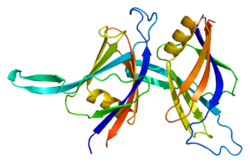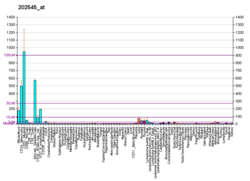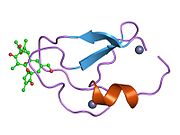| PRKCD |
|---|
 |
| Available structures |
|---|
| PDB | Ortholog search: PDBe RCSB |
|---|
| List of PDB id codes |
|---|
2YUU, 1YRK |
|
|
| Identifiers |
|---|
| Aliases | PRKCD, ALPS3, CVID9, MAY1, PKCD, nPKC-delta, protein kinase C delta |
|---|
| External IDs | OMIM: 176977; MGI: 97598; HomoloGene: 55963; GeneCards: PRKCD; OMA:PRKCD - orthologs |
|---|
| EC number | 2.7.10.2 |
|---|
| Gene location (Human) |
|---|
 | | Chr. | Chromosome 3 (human)[1] |
|---|
| | Band | 3p21.1 | Start | 53,156,009 bp[1] |
|---|
| End | 53,192,717 bp[1] |
|---|
|
| Gene location (Mouse) |
|---|
 | | Chr. | Chromosome 14 (mouse)[2] |
|---|
| | Band | 14 B|14 18.82 cM | Start | 30,317,311 bp[2] |
|---|
| End | 30,348,167 bp[2] |
|---|
|
| RNA expression pattern |
|---|
| Bgee | | Human | Mouse (ortholog) |
|---|
| Top expressed in | - monocyte
- granulocyte
- right adrenal cortex
- right uterine tube
- mucosa of transverse colon
- left adrenal gland
- left adrenal cortex
- right lobe of thyroid gland
- left lobe of thyroid gland
- rectum
|
| | Top expressed in | - lateral geniculate nucleus
- granulocyte
- medial dorsal nucleus
- medial geniculate nucleus
- lateral septal nucleus
- pyloric antrum
- seminiferous tubule
- epithelium of stomach
- large intestine
- colon
|
| | More reference expression data |
|
|---|
| BioGPS |  | | More reference expression data |
|
|---|
|
| Gene ontology |
|---|
| Molecular function | - kinase activity
- ATP binding
- protein kinase activity
- non-membrane spanning protein tyrosine kinase activity
- metal ion binding
- kinase binding
- enzyme binding
- insulin receptor substrate binding
- transferase activity
- protein binding
- calcium-independent protein kinase C activity
- protein kinase binding
- nucleotide binding
- enzyme activator activity
- protein serine/threonine kinase activity
- protein kinase C activity
| | Cellular component | - cytoplasm
- cytosol
- membrane
- cell-cell junction
- perinuclear region of cytoplasm
- nucleus
- nuclear matrix
- endoplasmic reticulum
- extracellular exosome
- plasma membrane
- nucleoplasm
- extracellular region
- azurophil granule lumen
| | Biological process | - intrinsic apoptotic signaling pathway in response to oxidative stress
- termination of signal transduction
- interferon-gamma-mediated signaling pathway
- negative regulation of protein binding
- positive regulation of endodeoxyribonuclease activity
- platelet activation
- protein phosphorylation
- cellular senescence
- negative regulation of insulin receptor signaling pathway
- positive regulation of sphingomyelin catabolic process
- cell chemotaxis
- cell cycle
- negative regulation of inflammatory response
- positive regulation of protein dephosphorylation
- Fc-gamma receptor signaling pathway involved in phagocytosis
- positive regulation of apoptotic signaling pathway
- stimulatory C-type lectin receptor signaling pathway
- cellular response to hydroperoxide
- negative regulation of peptidyl-tyrosine phosphorylation
- defense response to bacterium
- negative regulation of MAP kinase activity
- positive regulation of response to DNA damage stimulus
- positive regulation of protein import into nucleus
- interleukin-10 production
- regulation of actin cytoskeleton organization
- negative regulation of actin filament polymerization
- regulation of mRNA stability
- phosphorylation
- protein stabilization
- regulation of signaling receptor activity
- negative regulation of filopodium assembly
- cellular response to angiotensin
- interleukin-12 production
- peptidyl-threonine phosphorylation
- positive regulation of ceramide biosynthetic process
- neutrophil activation
- intracellular signal transduction
- negative regulation of glial cell apoptotic process
- negative regulation of platelet aggregation
- positive regulation of phospholipid scramblase activity
- B cell proliferation
- immunoglobulin mediated immune response
- positive regulation of glucosylceramide catabolic process
- peptidyl-tyrosine phosphorylation
- positive regulation of superoxide anion generation
- activation of protein kinase activity
- signal transduction
- cellular response to hydrogen peroxide
- peptidyl-serine phosphorylation
- apoptotic process
- neutrophil degranulation
- execution phase of apoptosis
| | Sources:Amigo / QuickGO |
|
| Orthologs |
|---|
| Species | Human | Mouse |
|---|
| Entrez | | |
|---|
| Ensembl | | |
|---|
| UniProt | | |
|---|
| RefSeq (mRNA) | NM_006254
NM_212539
NM_001316327
NM_001354676
NM_001354678
|
|---|
NM_001354679
NM_001354680 |
| |
|---|
| RefSeq (protein) | NP_001303256
NP_006245
NP_997704
NP_001341605
NP_001341607
|
|---|
NP_001341608
NP_001341609 |
| |
|---|
| Location (UCSC) | Chr 3: 53.16 – 53.19 Mb | Chr 14: 30.32 – 30.35 Mb |
|---|
| PubMed search | [3] | [4] |
|---|
|
| Wikidata |
| View/Edit Human | View/Edit Mouse |
|

 1bdy: C2 DOMAIN FROM PROTEIN KINASE C DELTA
1bdy: C2 DOMAIN FROM PROTEIN KINASE C DELTA 1ptq: PROTEIN KINASE C DELTA CYS2 DOMAIN
1ptq: PROTEIN KINASE C DELTA CYS2 DOMAIN 1ptr: PROTEIN KINASE C DELTA CYS2 DOMAIN COMPLEXED WITH PHORBOL-13-ACETATE
1ptr: PROTEIN KINASE C DELTA CYS2 DOMAIN COMPLEXED WITH PHORBOL-13-ACETATE 1yrk: The C2 Domain of PKC<delta> is a new Phospho-Tyrosine Binding Domain
1yrk: The C2 Domain of PKC<delta> is a new Phospho-Tyrosine Binding Domain























